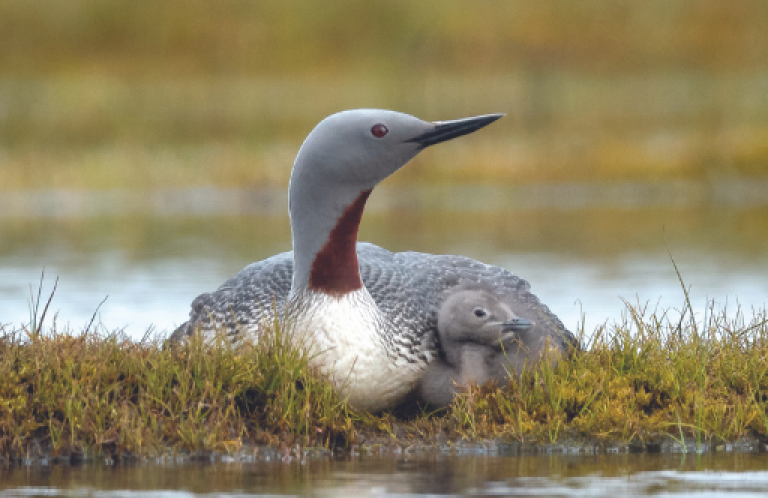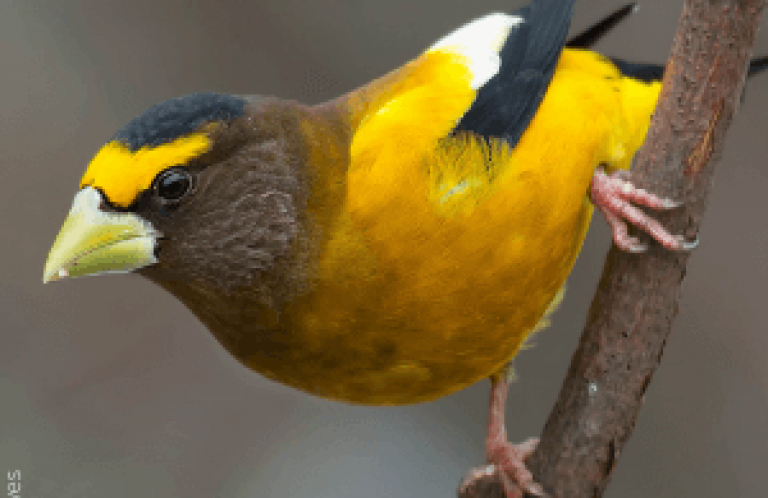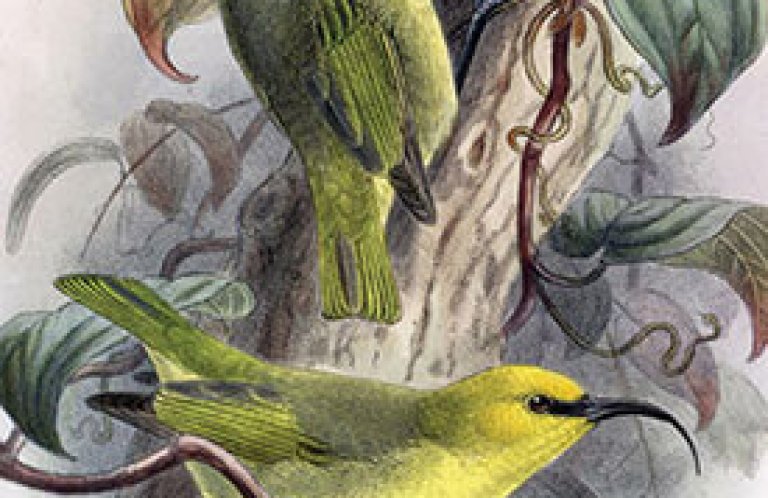Demystifying Rosy-Finches: Understanding the American West's Off-the-Grid Endemics

About 250,000 years ago — just a few moments in evolutionary time — small songbirds, likely patterned in brown and pink, island-hopped from Asia to what would become Alaska. Over the ensuing millennia, these birds' descendants spread across western North America and evolved into three of our continent's least-studied songbirds: the rosy-finches.
North America's three rosy-finch species — Black, Brown-capped, and Gray-crowned — breed at among the highest altitudes of any birds on the continent, nesting along talus slopes and snowfields at up to 14,000 feet. (A fourth species, the Asian Rosy-Finch, is similarly distributed in northern Asia.) These birds forage for insects and seeds on bare soil and amid sparse tundra vegetation, traveling in small flocks that, because they seldom encounter humans, can be surprisingly tame.
Due to the inaccessibility of rosy-finches' habitat, many of the surveys traditionally used to assess trends in North American bird populations miss them almost completely. The annual Breeding Bird Survey, for example, is conducted by counting birds along roads. In winter, rosy-finches descend to lower elevations, but their nomadic habits mean that even then, it's hard to get a handle on their numbers.
The threat of climate change spurs new urgency to learn more about the health of these remote populations.
In Utah, Colorado, and beyond, a hardy group of ornithologists is working to unravel the rosy-finches' secrets, make better estimates of just how many of these birds there are, and predict what will become of them as the cold, snowy mountain reaches they depend on begin to warm.
Ambassadors of the Alpine
When Janice Gardner pictures the animal that best represents alpine habitat for her, she doesn't imagine a wolverine, a pika, or a ptarmigan. Instead, she thinks of a rosy-finch.
“They're in the most harsh climates,” she says. “They're just incredible, hardy birds that don't seem to be fazed by snowstorms or really nasty winds.”
Gardner, an avid skier, has been familiar with rosy-finches for a long time — they're known to show up at birdfeeders at some of the West's most famous ski resorts. An ecologist with a Utah-based conservation nonprofit called the Sageland Collaborative, she's been heading up, for the past four years, a multipronged effort to answer basic questions about all three rosy-finch species, such as how they move across the landscape.
One component of the project involves fitting birds with leg bands containing individually identifiable microchips that can be “read” by special high-tech feeders hosted by ski resorts, allowing researchers to follow the movements of individual birds over time and estimate their lifespans. (So far, some tagged birds have continued to reappear for three years.) Another study analyzes isotopes in rosy-finch feathers to determine where the birds were when those feathers were grown.
Preliminary results from this project show that Utah is the winter home for Black Rosy-Finches that breed in several Rocky Mountain states, including Montana.
You don't have to be a scientist to participate in the Rosy-Finch Conservation Project, however. For the past three winters, Gardner has been recruiting volunteers throughout the West to submit counts of rosy-finches at backyard feeders during the winter, when these birds are known to wander widely. Participants from 11 states are now gathering data to help illuminate the details of rosy-finches' distribution and migration.

Origins of Three Species
While Gardner and her colleagues continue working to analyze their data, another study has provided new hints about how North America's three rosy-finches came to be in the first place.
During part of the 1980s and early 1990s, all three North American rosy-finches were lumped together as a single species, in part because genetic work had suggested that the differences in their DNA were minimal. In 2020, a team of scientists led by Erik Funk, then a Ph.D. student at the University of Colorado and now a postdoc at the San Diego Zoo Wildlife Alliance, published the first study to sequence the entire genomes of this group of birds.
Funk and his colleagues concluded that the Black, Brown-capped, and Gray-crowned Rosy-Finches are distinct enough that they should continue to be considered separate species, but that their populations have continued to interbreed and share genes over time.
The most striking DNA differences between groups of rosy-finches were, unsurprisingly, related to their plumage coloration (each species has its own pattern of brown, gray, black, and pink) and their ability to function at high altitudes. Amazingly, some of the same genetic pathways used by rosy-finch populations to keep their physiological processes going even at low oxygen levels have been found in human populations in the Tibetan Himalayas.
These are genes, with locations in the genome that allow them to be reshuffled and rearranged relatively easily, that provide a clue about how North America's three species were able to diverge so quickly. Funk speculates that the rosy-finch ancestor crossed the Bering Sea from Asia, "followed by this range expansion south, and then it seems likely that there were probably a couple of different pockets that got isolated by glaciers in the last Ice Age." Cut off from each other by advancing glaciers, these separated populations continued to evolve on their own species trajectories after the ice receded.
Janice Gardner and Erik Funk are both part of the Rosy-Finch Working Group, which was formalized in 2021 and includes representatives from state agencies, nonprofits, and universities throughout rosy-finches' range. The group meets regularly to exchange ideas and set research priorities. One goal is to develop improved, standardized survey methods, finally making it possible to accurately monitor rosy-finch populations. In Colorado, this effort is already beginning to produce results.
“The Hardest Work I've Ever Done”
In 2015, the Brown-capped Rosy-Finch, which is found almost exclusively in Colorado, was named a “tier one” species under that state's Wildlife Action Plan, meaning it is a “species of greatest conservation need.” The International Union for Conservation of Nature (IUCN) considers it, and the Black Rosy-Finch, Endangered. As is the case with rosy-finch populations throughout the West, there was a lack of reliable data on the actual health of the Colorado Brown-capped Rosy-Finch population. But these birds are known for their love of cold and snow, and the state has already been getting warmer — a 2014 report found that Colorado has warmed by more than two degrees Fahrenheit since the mid-1980s, a trend that is predicted to accelerate.
In 2018, Colorado Parks and Wildlife decided to fund a three-year project to finally get some answers about just how many birds were out there. Biologists would trek into the birds' roadless mountaintop habitats to conduct the first detailed surveys of the species. Kat Bernier, a former wildlife technician for the agency, has been heading up the study as part of her Ph.D. research at the University of California, Santa Cruz.
Bernier and her colleagues randomly selected 57 mountain basins within potential rosy-finch habitat. At each one, a pair of surveyors walked parallel line transects while counting and recording the birds they saw.
The first word Bernier uses to describe the surveys is “grueling.” “Often we would start pre-dawn and hike several miles up a trail to access a site, and then hike off-trail to get into the actual position where we would do our surveys,” she says. “Then it was a long day of walking slowly and looking for birds on 45-degree rock slopes, on unstable footing and crumbling rock. The rosy-finch project is by far the hardest wildlife technician work I've ever done, just because of the steep, rugged terrain.”
After three years of hard work, Bernier and her colleagues finalized their results in early 2023: Colorado, according to their analysis, is home to an estimated population of between 115,000 and 150,000 Brown-capped Rosy-Finches — more than three times the estimated total population listed in a Partners in Flight report from 2016. Contrary to what some had feared, this is a healthy population.
Bernier and her fellow biologists also documented the habitat features where they found the birds. Rosy-finches preferred to spend time near cliffs and snow patches, avoiding areas with dense vegetation, and were most common at elevations between 11,500 and 13,200 feet.
Bernier says that she, at least, was not surprised by the robust numbers of birds they found. “I had so many years of experience in the alpine of Colorado, surveying [other wildlife],” she says, “and rosy-finches were everywhere, all of the time.” A similar assessment in Idaho focusing on Black Rosy-Finches is currently underway, although the results are not yet public.
These results provide an important baseline for future monitoring. Colorado Parks and Wildlife plans to repeat these surveys periodically using the same methods to get a better sense of whether the population is holding steady, or if it will begin to decline as climate change further alters the Brown-capped Rosy-Finch's habitat.
If counting how many rosy-finches there are now is hard, predicting the future may be even harder. But at least some scientists who study rosy-finches believe that these little pink-and-brown birds may prove surprisingly resilient.

A Rosy Future?
According to a 2019 report by the National Audubon Society, if Earth's climate warms by just two degrees Celsius (about 3.6 degrees Fahrenheit), the Gray-crowned Rosy-Finch will lose 48 percent of its current suitable habitat, the Black Rosy-Finch will lose 79 percent, and the Brown-capped Rosy-Finch, the species on which Kat Bernier focused, will lose a staggering 99 percent. There is reason to be gravely concerned about these birds' future. But don't count them out just yet.
Matt DeSaix, a Ph.D. student with Colorado State University's Bird Genoscape Project, headed up a new genetic analysis of Brown-capped Rosy-Finches that was published last year, with an eye to both the species' current genetic health and what the future might hold. He and his colleagues sequenced genes from feather and blood samples collected from birds at 11 sites spanning the species' breeding range. They found no concerning lack of genetic diversity, nor any evidence of inbreeding at any of their sites, supporting Bernier's conclusion that the population is robust.
They also attempted to peer into a genetic crystal ball. DeSaix's project combined two methods of forecasting what might happen to rosy-finches in a warming world: ecological niche modeling, which looks at how the distribution of habitat meeting a species' current requirements is likely to shift in the future, and genomic offset, which looks at how much genetic adaptation a population would likely have to undergo to keep up with changing climate conditions in the birds' current home.
DeSaix's analysis suggests that the area of good rosy-finch habitat will contract and that some amount of natural selection will need to happen for populations' local adaptations to continue to fit the places they live. “It's both,” he says. “They're going to have less suitable habitat, and to stay within this area, they're going to need to adapt as well.”
But, he cautions, we still really don't know enough about these birds and how they use their habitats to say for sure what will happen. For one thing, the highly varied jumble of ridges and basins in their mountain habitat can create small pockets of cooler habitat that persist at lower elevations even as the area around them warms.
Pika, small relatives of rabbits that rely on similar alpine habitat, have already shown an ability to make use of these “microhabitats” to adapt to changing conditions.
DeSaix is optimistic about rosy-finches' prospects. “So many people are just stoked about rosy-finches and want to protect them, and I'm happy seeing the high genetic connectivity, I'm happy seeing the stable base popula-tions,” he says. Climate forecasting, he points out, is inherently uncertain.
According to Janice Gardner, the Rosy-Finch Working Group is already striving to identify potential ways to help buffer rosy-finches against the worst effects of climate change. Possibilities they hope to explore include improving habitat in the birds' lower-elevation winter ranges by promoting native plants and fighting invasive weeds, and physically removing trees that may encroach upslope into rosy-finches' winter foraging habitat as temperatures warm.
“I'm hopeful that the story of the rosy-finches is a good one and that we can ensure that they persist into the future,” she says. “They're really neat species that I think a lot of people [in the West] can relate to — they like a good snowstorm like a skier does, and they're kind of desert rats, too — they can be a bit nomadic.”
When asked if she identifies with rosy-finches a little bit, she laughs. “Maybe I wish I was more like a rosy-finch,” she admits, “instead of being stuck here reading emails all day.”
Those living in rosy-finch territory can learn how to submit feeder counts to the Rosy-Finch Conservation Project — including reports of no rosy-finches, which are also valuable. Visit: sagelandcollaborative.org/rosy-finch.
This story was originally published in Bird Conservation (Spring 2023), American Bird Conservancy's member magazine. If you would like to receive the print version of our magazine, follow this link to become a member and enjoy this benefit.



















































